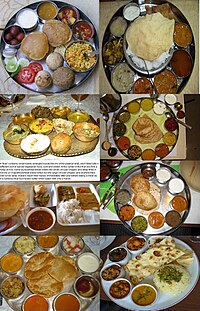History of Tamil cuisine(Influence abroad &Typical Tamil feast - Virundhu Sappadu )
Influence abroad [edit]
Historically, Tamil cuisine has traveled to many parts of the world. Most notably traces were found by archeologists that Tamil cuisines were supplied to the ancient Rome. It traveled toPhilippines, Greece, Middle East, Malaysia, Singapore and Thailand via traders (Nagarathar) from Tamil Nadu who are Karaikudi Chettiars. Along with Chinese, it has influenced these international cuisines to what they are today, especially one can see the impact of Tamil cuisine in Malaysian cuisines like parotta kurma (Roti canai/Roti Telur) and curried items. South Africa, Trinidad and Tobago, Guyana, Martinique, Guadeloupe, Mauritius, and Réunion Indian cooking is also influenced by Tamil cuisine, which was brought by Indians in the late 19th century.
Typical Tamil feast - Virundhu Sappadu
‘Virundhu’ in Tamil means ‘feast’, when guests (friends and relatives) are invited during happy ceremonial occasions to share food. ‘Sappadu’ means a full course meal, which will usually be a lunch or dinner affair. Marriage festivities could also be a 'virundhu' saapaadu at breakfast times if the marriage is solemnized in the morning hours.
In the olden days guests would sit on a coir mat rolled out on the floor and a full course meal was served on a banana leaf. Nowadays, the same exercise is done but guests sit on a dinner table and have the same type of food. Traditionally the banana leaf is laid so that the leaf tip is pointed left.
The host will ensure that the menu includes as many variety of dishes as possible and guests are served as many helpings as requested. The dishes are served in a particular sequence, and each dish is placed on a particular spot of the banana leaf. Guests are expected to begin and end eating the meal together and do not leave in middle of a meal. With a look at the food on the leaf, guests will have a good idea of the community, wealth, and the region from which part of Tamil Nadu the hosts originate.
The top half of the banana leaf is reserved for accessories, the lower half for the rice. In some communities, the rice will be served only after the guest has been seated. The lower right portion of the leaf may have a scoop of warm sweet milky rice Payasam, Kesari, Sweet Pongal or any Dessert items. While the top left includes a pinch of salt, a dash of pickle and a thimbleful of salad, or a smidgen of chutney. In the middle of the leaf there may be an odd number of fried items like small circles of chips either banana, yam or potato, thin crisp papads or frilly wafersAppalams and vadai.
The top right hand corner is reserved for spicy foods including curry, hot, sweet, or sour and the dry items. If it is a vegetarian meal, the vegetables are carefully chosen, between the country ones-gourds, drumsticks, brinjals-and the 'English' ones, which could be carrot, cabbage, and cauliflower. (If it is a non-vegetarian meal, a separate leaf is provided for the fried meats, chicken, fish, crab, and so on.) But again, the variations are presented carefully, one dry one next to a gravied one.
There may be side attractions such as poli, poori, Chappati, some of the famed rice preparations such as GheePongal or Puliyodarai (tamarind rice) particularly if the family comes from Thanjavur, known as the rice bowl of Tamil Nadu.
Traditionally, sweets are eaten first. After having worked through the preliminaries, the long haul starts with rice. Sambar is added to rice and eaten with maybe a sprinkling of ghee. This is followed by rice with Kuzhambu and rice with Rasam. A final round of rice with curd or buttermilk signals the end of meals. Though there are varieties of kuzhambu, only one will be on offer in a given day. A banana may be served last.
After the meals, betel leaves and nuts are chewed in a leisurely way. Hearty banter and small talks of the times gone by are discussed with nostalgia. It is a time to reminisce the past. The betel leaf chewing is a traditional habit and was a preserve of the older folks. The betel leaf is packed into a little 'package' with edible calcium paste layered on top and a pinch of coarsely powdered betel nuts.


Comments
Post a Comment